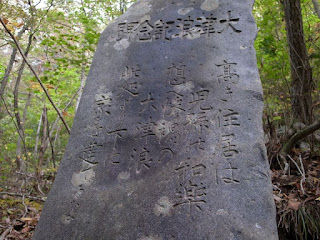Unlock your Ancestral Wisdom
 |
| Japanese Tsunami Stone |
higher place.” This worked. During the 2004 tsunami that devastated Aceh, the death toll on Simeulue Island was only 7 out of 78,000 [2]. We all now qualify as ancestral survivors of a global calamity. What I wish my grandmother had told me was about all of the “optional” barriers to cooperation that humans erect in a crisis. I want to be a better ancestor than Esther was. Here is what I would put on my ancestor rock.
“Harken. When you see a press release about a remote uptick of strange life threatening lung symptoms and fevers pay attention to your neighbors. The pale rider of pestilence never rides alone. Your all too human relatives, friends, health experts, and politicians will do unhelpful things. Act quickly to insist that this is a time for working together in trying to understand the nature of threat and doing thoughtful things based on the best available data. Do not overestimate how much you know. Do not underestimate how rotten people will be in taking personal advantage of the trouble.
Here is what to expect.
Expect Arrogance Instead of Humility
That first report of the first cases in the outbreak will be shrouded in unknowns. “What is the cause? Is it serious? Is it airborne? Who is at risk? What should I do?” Instead of humility, many display unjustified arrogance. Experts will assume that this outbreak will be like the last epidemic and will have the same solutions and the same time course. But that will not be true. SARS was not like influenza. COVID-19 was not like SARS. Decisions are necessary but pontificating is unjustified. A real expert would say “This is new, we will not have answers for a while. When we do get answers, the answers will change. Get ready.”
Expect Denial Instead of Action
Piglet: “Supposing a tree fell down, Pooh, when we were underneath it?”
Pooh: “Supposing it didn’t.”
It is a healthy thing to be an optimist like Pooh on an average day in the forest. But optimism needs to be checked when news reports say there is person to person transmission of a serious airborne infection. If people’s breath makes other people sick, Piglet is right and you are probably underneath the tree. Going into denial because the first cases are far away makes you a bear of very little brain.
Expect Panic and its Corollaries: Blame and Fake Simple Solutions
Panic will come faster if those in charge say, “There is nothing to fear”. Leaders will not know better than to say that. Better to say “This could be bad, here is what we know, there is still a lot we don’t know, let’s stick together.”
Inevitably the blamers arrive. People in fear want the quick relief from blaming
scapegoats. The exploiters arrive fast with people to blame and fake
solutions. It will be hard for most
people to know who to trust.
What to Do Before It's Too Late
It might be one decade or ten decades before another pandemic. My preparedness advice is not about stockpiling masks or gloves or sanitizer. It is not about big data systems to predict which bat cave and which virus. Let others draw plans for bio-tech to parachute in and save us next time. Incorrigible humans need human-friendly institutions.
We need a generation of embedded public health leaders in all health departments who know how to listen, to do two way communication and to build trust. Those are the tools that were in shortest supply to counter arrogance, denial, panic and blame. While still devoting the best minds in science to discover new stuff—we also need a moonshot to explain the old stuff to the people of earth in a way that they can understand, trust, and believe.
The public health profession and its professional schools
had 101 years from 1918 to 2019 to build the practicing professional’s ranks and their capability in
trust-building, communication, and community-creating in public health. We must do better. Now that we are all ancestral survivors of
calamity we have an important song to sing.
David Bishai is Clinical Professor and Director of the Hong Kong University School of Public Health
[1] Lewis, Danny “These Century-Old Stone “Tsunami Stones” Dot Japan’s Coastline” Smithsonian Magazine August 31, 2015.
[2] Syafwina “Recognizing Indigenous Knowledge for Disaster Management” Procedia Environmental Sciences 20 573-582 Vol 20.

Comments
Post a Comment